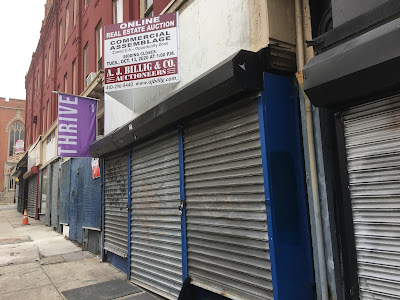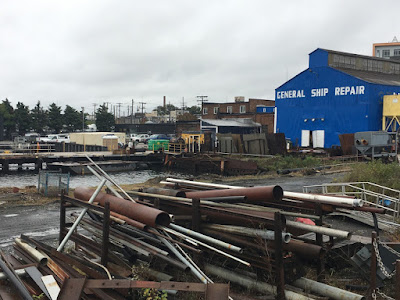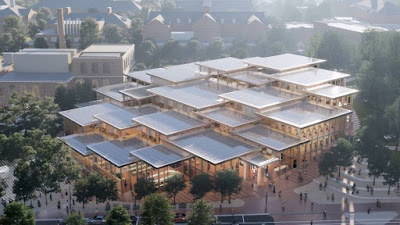 |
| Event poster of the Baltimore Transit Equity Coalition |
- The final Regional Transit Plan published by the MTA in close collaboration with regional representatives.
- The ENO report Transit Reform for Maryland: New Models for Accountability, Stability, and Equity
- The Capital Region Rail Vision issued by the Greater Washington Partnership with a look towards Baltimore by proposing to integrate the VRE and MARC commuter trains.
 |
| More bus lanes to accelerate the bus |
Finally, there is the Transportation & Climate initiative, a compact between 13 states of the eastern US (including Maryland) which will introduce carbon pricing and trading into transportation. While not a Baltimore region initiative, TCI has enormous potential to shift transportation priorities and open up new funding streams, especially for transit.
 |
| The Transportation Report Card by CMTA |
A typical Baltimorean can only get to 9% of the region’s jobs in under an hour using public transportation. (Report Card)
According to data collected by the Federal Transit Administration, MTA’s bus and rail systems have the highest breakdown rates compared to its peer agencies (2018 data, cited in CMTA Report Card_Would the three plans and the proposed bills improve area transit?
Since the biggest problem for transit is the lack of money, the Investment Act would make a difference since this governor consistently prioritized roadway spending over transit ever since he took office. With COVID having drastically decreased the dollars flowing into the Maryland Transportation Trust Fund, which fuels all matters and modes of transportation in Maryland, the Governor announced especially drastic cuts for MTA. The proposed bill squarely aims at funding MTA for a "good state of repair", if need be, by reallocating other transportation funds towards transit.
To make financial matters worse, the single large transit project that the Governor let happen, the DC area Purple Line, hit a big snag when the lead contractor walked off the job frustrated by the many delays that the project organized as a public private partnership has experienced. In a settlement, designed to rescue the partially constructed project, the State will have to pay at least $100 million to get the project moving again. Although it isn't clear yet what the total tally of this major hick-up will be, nor from where the funds will come, there is little doubt that the Transportation Trust Fund will pay this settlement which was celebrated as a success, both by MDOT and by transit advocates.Requiring the Governor to include certain appropriations in the State budget from the Transportation Trust Fund to the Maryland Transit Administration for certain operating and capital needs of the Administration in certain fiscal years; (Bill description)
Over the past two years, MDOT MTA has worked collaboratively with the Central Maryland Regional Transit Plan Commission, the Baltimore Metropolitan Council, and the public to develop a comprehensive twenty-five-year vision for transit in the Central Maryland Region: Baltimore City and Anne Arundel, Baltimore, Harford, and Howard Counties.The Central Maryland Regional Transit Plan presents goals, objectives, and initiatives to enhance transit service, support the economy, and reduce our environmental impact. Through coordinated planning and investment from the region’s transit agencies and the local jurisdictions, we have an opportunity to create an interconnected transit network that is more reliable, convenient, and efficient.
 |
| Goals and Initiatives (Regional Transit Plan) |
The Regional Plan, initiated long before anybody remotely thought about a virus, addresses several of the typical issues that plagued our transit all along, namely lack of reliability, not enough destinations to reach within a reasonable time, long trip times, a poor state of repair and poor communication. Addressing these issues will be good, no matter what. The plan also identifies various priority corridors that should be studied for expanded service without suggesting a mode (bus, light rail, subway etc). All metrics and goals in the plan are based on improvements above pre-COVID services. Since the pandemic resulted in service cuts rather than improvements, all metrics are already off to some extent.
 |
| Ridership loss on buses: MTA has the third smallest loss in the nation (Source: MTA) |
The governance of public transit in Greater Baltimore limits its ability to address those regional transportation needs. Of the 50 largest transit agencies in the country, Baltimore’s is the only one that is governed and operated by a state agency without a board of directors.[...] The local governments in the Baltimore region do not directly contribute funding to the transit services the state provides.
Unfortunately, under this governance structure, metropolitan Baltimore’s public transportation system has not kept pace with repair and service needs nor has seen a new rapid transit line in more than two decades.
ENO points out that Baltimore does not contribute to the area transit cost. In that it is unique, since the surrounding jurisdictions such as Howard, Anne Arundel and Harford Counties get operational aid from MTA but contribute to their capital and operational expenses to varying degrees. Baltimore, of course, runs its own Circulator bus, largely funded out of City funds. ENO suggest that the hodge-podge of local systems should be integrate into one system if a regional authority would run it.
While funding of a regional authority would still come mostly from the State Trust Fund, the aspect of increased local contributions may very well lower Baltimore's excitement about this model.
The Capital Rail Vision
Finally the rail vision plan which isn't strictly a Baltimore area plan. It proposes to integrate Maryland's MARC commuter trains and Virginia's VRE trains which current each terminate at Union Station in DC. MTA's MARC trains were the agency's flagship service with rising ridership and the fastest commuter trains in the country (top speeds above 100mph). It is tempting to look at how this service could penetrate the nation's capital better and potentially even reach up to the Philadelphia commter rail system as well.
The Capital Region Rail Vision seizes on recent wins for the region’s rail network and charts a course for a transformed rail system that offers seamless, all day connections that span the Potomac River and rail operators to connect Maryland, the District, and Virginia and deliver a globally competitive system that takes the Capital Region to new heights.
But oh, have things changed! A recent presentation by MTA Administrator Kevin Quinn cast a light on the current conditions. Like in transit across the country, MTA lost riders in droves, nearly 90% for rail services and commuter buses and about 50% for local buses. With such devastation in the commuter rail ridership, it isn't likely that this vision will get much traction any time soon, even though a State bill introduced last year, already asked to study how MARC service could be extended to DC's L'Enfant Plaza, currently only served by VRE.
 |
| The Capital Region Commuter Rail system |
The high ridership losses on MARC come from our region's high dependency on government work, especially for commuters riding MARC to DC. Almost all this work is now done virtually and it is quite unclear to what extent in person work will return even once COVID is in the rear view mirror.
Commuter rail is hugely important for the well being of the Baltimore region, which is dependent on participating in the much healthier capital economy. In spite of the cratering passenger numbers, it is the time to fully appreciate the importance of high capacity trains that connect our region. They should be more than a conduit for federal workers. Instead of wasting energy on far fetched boondoggles such as MagLev and Hyperloop, the focus of our regions must now be how to replace the missing federal commuters with everyday riders that currently clog the streets.
The "captive ridership" trap
Common wisdom has it that the pandemic accelerates and magnifies trends that were detectable long before the pandemic. Certainly true for transit: The increase in ridership that had followed the financial crisis of 2008 has long reverted back to the steady loss of transit's share that has been underway for as long as mass motorization. The future of transit depends on reverting this trend in the name of climate change and a better quality of life in our road congested and air polluted region.
In spite of the pandemic and the associated fear of sharing a space with others, in spite of work from home, closed schools and closed government offices, nearly 100,000 people still use the buses every day! This means, tons of "front line" or "essential" workers depend on transit for getting to work! If these employees, nurses, sanitation workers, shop clerks, check-out personnel, construction workers, delivery drivers, or warehouse workers couldn't get to their jobs, our society wouldn't function anymore and all those who get by without touching transit would have a rude awakening.
 |
| Zurich trams: Not spectacular but reliable (Photo: Philipsen) |
In fact, Baltimore's transit dependent population is higher and the 50% ridership in loss is smaller than that of many other cities. This points to Baltimore's high poverty rates and the large inequality and inequity in this city. Protecting these riders has become a clarion call for those who demand more equity. The observation that transit is a necessity is not new, though. However, in the past it was seen as a trap if agencies would simply rely on "captive riders" for whom transit is a last resort.
As a result transit agencies have tried to attract "choice riders" (meaning riders that have a choice), often by building rail service which had a higher acceptance than buses. This approach has come into the cross hairs of the equity discussion. Posh new suburban light rail systems were increasingly derided as "white rail" and as an inequitable shift of resources away from overburdened and underserved communities where transit is truly needed. Attracting choice riders was criticised as some type of trickle down approach in which the new attractive services should eventually improve bus service as well. On the other hand, it is probably true that transit won't excel unless broader segments of the population have some "skin in the game", best by being transit users themselves.
 |
| Who can tele-work? Source: MTA |
The master precedent for attracting "choice riders" had been Zurich, Switzerland, interestingly Zurich was successful after it rejected very expensive new underground lines that would have done away with its narrow gauge trams in the streets and opted for making those trams an investment priority instead. Only after the transit agency resolved that it wanted to improve its existing system but didn't want to be just a service of last resort, did the service really improve. Making existing trams and buses more reliable, cleaner and operating them with use of state of the art technology and giving transit priority in the narrow streets of the city made it one of the best systems worldwide. That approach had been very successful and today, all segments of the population rub shoulders in the many tram lines around the city.
What needs to be done?
Considering COVID, equity and the Zurich experience raises many questions for Baltimore's transit future beyond the noted transit plans.
- How can the region respond effectively to climate change? What role must transit play in that?
- How can transit help to reduce the inequities in the region by providing much better job access without breaking the bank?
- How can transit service respond to continued migration of jobs away from the traditional job centers?
- How can transit become attractive beyond the existing "insider" circle of those who are familar with the system and all its indignities? Good transit has to be attractive to transit dependent riders and choice riders alike.
MTA and the City of Baltimore have started many good initiatives:
- a fairer distribution of the existing street space through miles of bus only lanes and many cases of signal priority which have broken with the tradition of traffic planning that always prioritized the car over everything else.

The new MTA Nova Bus being rolled out now - MTA's buses have become "smarter" and MTA's dispatch folks as well as riders can usually find where any bus is at any given moment.
- The bus fleet is in the process of being renewed and MARC, light rail and Metro also have seen upgrades for their rolling stock (or will see it in 2021, in the case of Metro).
- MTA is preparing for a regional fare system where riders could use a single ticket on various transit providers in the region.
- Service remains slow and unreliable and trips too time consuming as CMTA's transit report card shows. The other deficits contribute to this:
- A poor state of repair for tracks, signals and stations, slowing things down.
- Insufficient number of buses, especially when break downs are frequent
- Insufficient number of operators, especially when COVID increases the sick rates
Only money can alleviate these deficiencies, no matter who runs the system or how ridership will develop after COVID. Severe service cuts taking out essential lifelines for underserved and overburdened communities must remain off the table. The Maryland Transit Safety and Investment Act will be key to the needed funding as well as the second COVID aid package that Congress just stitched together. It is anticipated to contain about $120 for Maryland Transit.
The Efficiency solutions: Better land use and demand based transit service
There are perspectives beyond money, namely how land use and transit service can be brought into better alignment. Better land use by the local jurisdictions via zoning and land management around the existing transit stations (rail) and bus lines would be the kind of support any transit agency needs to flourish. Although the connection between land use and transportation has been understood for decades, there has been little or no action in the Baltimore region to do anything about the fact that the land around rail stations is usually not at all "transit oriented" but is characterized by abandonment, disinvestment, low density and auto centric uses that don't bring any riders to transit. Masterplans and development plans need to recognize the presence of a transit station as an asset. The fact that in our region state money has funded transit and the stations has enabled local government to pretty much ignore those assets.
 |
| Typical suburban land use pattern (Graphic: Kittelson) |
A case in point is the Lutherville Light Rail station in which vicinity a shopping center has seen four different big box users since the station was built. None presented "transit oriented development", all failed one way or another. Recently the site was bought by developers just before it would have been auctioned off. What will happen now? There is no adopted local plan that would mandate a transit friendly use.
The same is pretty much true up and down all stations of MARC, Metro and Light Rail. The famed exceptions are Owings Mills for Metro, Symphony Center and Clipper Mill for Light Rail and the Dorsey Road and Odenton Stations for MARC, all examples which deviate in many respects from optimal TOD.
With better land use and a broader service menu, efficiency could be achieved, ideally without much new capital. This requires action on both sides:
- Intensified use around existing rail stations all across the map can bring additional riders to transit and out of cars. Putting development and jobs in areas that are well served by transit rather than out where transit is impractical is by far the most cost effective option for sustainable economic development
- A further diversified transit service menu must be considered by MTA to serve the many lower density areas in our region to to provide service during "slow" hours. The menu must include services that are not the traditional fixed-route, fixed-service model that is the base of all existing MTA service except Paratransit/Mobility.
- The operational service alternative is a demand-based system that runs when and where needed, replacing costly mostly empty buses circulating on routes with low ridership. Mobility-Paratransit is already a "demand-based" service that adjusts for demand and moves off fixed routes to the doors of users and their destinations.
- A cash free integrated fare payment system across all modes and the entire region which would allow buses to be faster since operators would not have to wait until everybody paid on board.


























